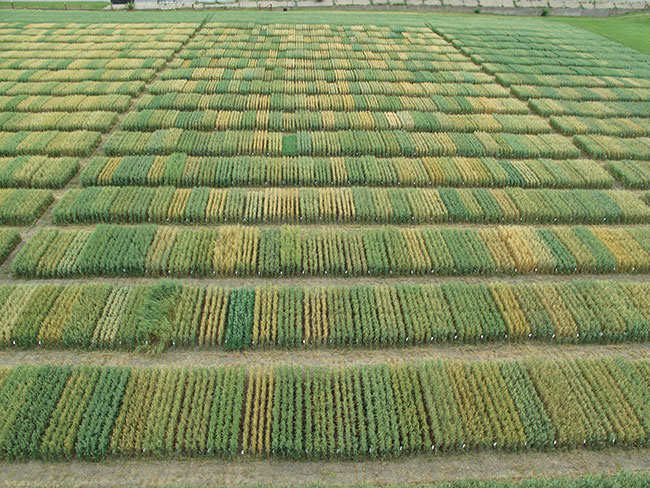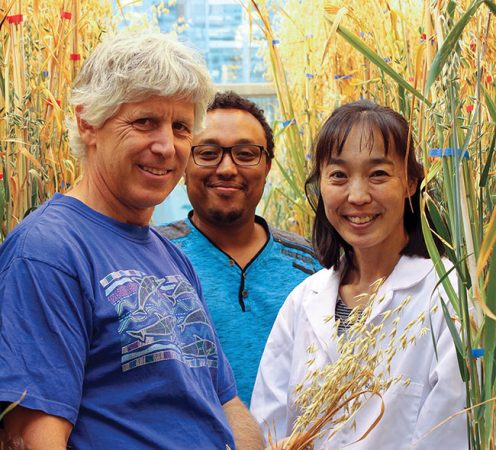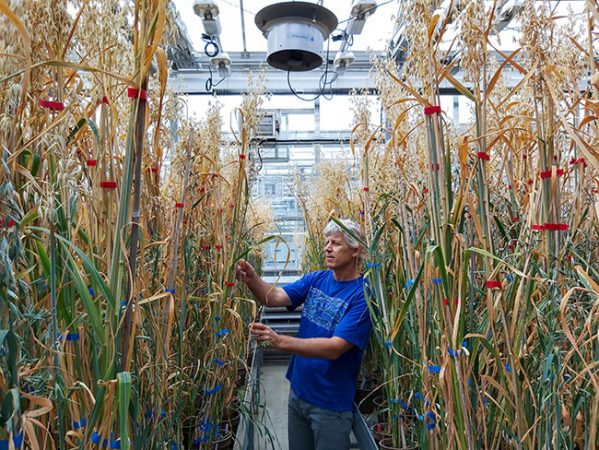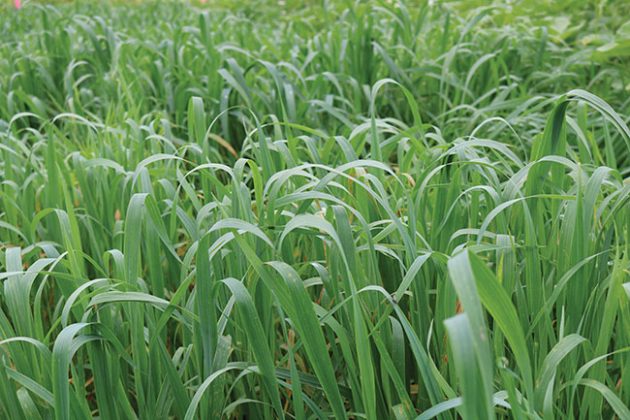
Features
Cereals
Plant Breeding
A springboard for oat improvement
Genomic advances for even better oat varieties.
November 18, 2019 By Carolyn King
 This oat genetic diversity experiment conducted by Tinker’s group illustrates the high degree of variability between different
oat varieties.
This oat genetic diversity experiment conducted by Tinker’s group illustrates the high degree of variability between different
oat varieties. When people think about oats, their first thoughts might go to simple foods like oatmeal. However, oat is anything but simple on a genomic level. Its huge, complicated genome makes developing genomic tools for improved oat breeding really challenging.
Fortunately, Nick Tinker and his research group at Agriculture and Agri-Food Canada (AAFC) in Ottawa are equal to the challenge.
Their research ranges from a leading-edge method for rapidly screening thousands of oat breeding lines for many genetic traits at once, to international collaborations in the essential efforts towards sequencing the oat genome. The ultimate goal of their work is to spur the development of even better oat varieties.
Oat lags a bit behind other crops in the development of genomic resources. In particular, unlike every other major crop and most minor crops, oat still lacks a high-quality complete genome sequence, called a reference genome. Tinker explains that there are two reasons for this lag.
The first reason is that the oat genome is unusually complex. “Its genome is very large, almost four times as big as the human genome. Also, it is a triple genome because oat evolved from three different wild relatives with smaller, simpler genomes that have glommed together. So sequencing oat’s genome is like doing three large, complicated jigsaw puzzles at the same time with the pieces of all three puzzles mixed together in a single box. So we need to take extra precautions to make sure we’re not assembling one of those puzzles, or sub-genomes, using pieces from another one.”
A further addition to the complexity is that oat has greater genomic variability between varieties, in comparison to most other crop species. He says, “That is partly because having those three genomes lets oat tolerate rearrangements among its chromosomes. So those three puzzles may look quite different from one oat variety to the next. This has made chromosome mapping very difficult.”
The second reason for the lag is funding constraints. “Oat is important worldwide, but almost everywhere it is less important than crops like corn, soybean, wheat and canola, so oat tends to get less funding. But because of the oat genome’s complexity, sequencing it is very expensive. So, within every country there is not enough funding to do big oat genomics projects, which is why international collaboration is so crucial.”

Tinker (left) with two members of his research group, Wubishet Bekele (centre) and Asuka Itaya (right).
On the road to a reference genome
A good reference genome would enable oat researchers to better understand things like how different genes affect different processes in the plant and to develop more genomic tools for oat breeding.
Tinker and his group have been instrumental in building the foundation needed to create an oat reference genome. In particular, four years ago, Tinker led an international initiative in the critical task of creating a really good map of the oat chromosomes, called a consensus map.
A chromosome map uses a set of DNA markers, which are like road signs, to put the genes in order. A consensus map is the best estimate of the average order of those road signs, based on many different maps. Figuring out this average is especially difficult in oat because of its greater genomic variability.
“Creation of the oat consensus map required participation from the international community because we needed to merge a lot of different maps from different oat varieties to determine which parts of the map were always the same, and which parts varied among varieties,” notes Tinker.
“The consensus map is a prerequisite for the complete genome sequence because you need those road signs when you’re doing the DNA sequence to help put all of the sequence into the correct order. And the map is still very useful even when you have a sequence.”
This consensus map is a major advance. “Without this map, we would be completely lost. Now almost every new oat genomics study done around the world depends on this map,” he says.
“The map also allows us to reinterpret older work. For example, let’s say somebody had mapped a rust resistance gene and all they knew was that the gene is linked to one other genetic marker. Now we can put it onto the complete map. And when we do that, we might discover that two rust genes that we thought were different are probably the same gene. Or now that we know where the gene is on the map, we can see that it is linked to a gene affecting oat quality, so we know it will be difficult to add that resistance gene without affecting quality.”
Before that road map could be made, all those road signs had to be created. And that’s another area where Tinker and his group have made substantial scientific contributions. They led the development of two technologies that provide inexpensive ways to put a whole lot of road signs on the road map at once. The resulting high-density set of road signs was key in building the consensus map.

Nick Tinker studies oat genomics with the ultimate goal of spurring the development of even better oat varieties.
Getting closer: draft genomes
Although there isn’t yet a reference genome for cultivated oat (Avena sativa), there are some draft genomes.
A Swedish consortium owns one of the drafts. This may be the most complete draft, but it isn’t publicly available for other scientists to see and freely use.
Another draft was produced by one of Tinker’s collaborators, a researcher from the University of North Carolina. Tinker notes, “This draft has been publicly available for a couple of years. However, it was done using an older technology that wasn’t able to properly separate the three sub-genomes, so it has a lot of limitations.”
A researcher at Aberystwyth University, another of Tinker’s collaborators, has created a draft sequence for red oat (a sub-species of Avena sativa). Red oat is cultivated in other parts of the world, but not in Canada. It is another triple-genome oat and is closely related to the white-seeded Avena sativa that we cultivate here. Its sequence will soon be publicly available and will help with efforts to sequence white oat and understand oat’s genetic diversity.
Tinker and his group were part of a collaborative effort led by a group at Brigham Young University that very recently completed reference sequences for Avena atlantica and Avena eriantha. These wild relatives’ genomes represent two of the three sub-genomes in Avena sativa. These two smaller genomes will also help with assembling the full genome sequence of Avena sativa.
Going wild
“Perhaps the project that was the most fun recently has been sorting out which parts of the oat genome came from each of its three wild ancestors,” Tinker says. “But I truly believe this work has long-term importance.”
Oat has about 30 wild relatives. These species are an amazing source of genetic diversity for traits like disease resistance to improve cultivated oat varieties. At present, a trait from a wild relative is brought into oat by making a cross between the wild relative and a cultivated oat line. “With those crosses, you get mostly garbage [because the wild plant has so many traits that are undesirable for crop production]. So you have to do a lot of selection [and backcrossing] to bring just that one gene from the wild relative into your crop,” he explains.
“However, many people believe we will soon be able to move desirable genes routinely from wild relatives into oat through gene editing – editing the genome of cultivated oat to look like the wild relative in the target genetic region. That is being done in other species, but we haven’t accepted gene editing in oat.”
“However, many people believe we will soon be able to move desirable genes routinely from wild relatives into oat through gene editing – editing the genome of cultivated oat to look like the wild relative in the target genetic region. That is being done in other species, but we haven’t accepted gene editing in oat. I don’t know when that might happen, but we need to do the basic science to prepare for that possibility so that gene editing in oat will be safe and efficient if it happens.”

Oat has about 30 wild relatives which are great sources for genetic diversity but also include a lot of traits that are undesirable for crop production. Photo by Stephanie Gordon.
A revolutionary advance
“Almost all my focus right now is on genomic selection, which is a way of selecting several different complex traits at once using models developed from thousands of genetic markers,” Tinker notes.
Genomic selection is a significant leap beyond marker-assisted selection where a genetic marker is used to identify breeding lines that have a specific gene associated with a particular trait. Those single markers are useful tools for some traits; for instance, resistance to certain diseases can depend on a single gene. However, traits like yield and quality are controlled by hundreds of genes.
Tinker outlines how a genomic selection model is created. “In genomic selection, you have a training population – a set of different oat lines that are part of your breeding program. You do a really careful evaluation in multiple environments of how those different oat lines perform [with respect to traits like yield, quality, disease resistance and so on]. You also measure all of the genetic markers in those same oat lines. Then you build a correlation between the markers and the traits of interest.”
Certain patterns of markers will end up being statistically associated with certain traits. Then you can use that statistical model to predict how other lines will perform.
“Let’s say you have another population of oat lines, perhaps a much larger population that you can’t afford to grow out in multiple plots and multiple environments. However, you can do the genetic marker assays on them, which right now only cost about $20 per oat line, and that cost is rapidly coming down.” So, using an oat line’s array of markers, the model can predict how that oat line will perform relative to the traits of interest, in a normal year in the target environment.
“Genomic selection is a revolutionary concept,” says Tinker. Until genomic selection, the only practical way for breeders to evaluate thousands of plants in the early stages of their breeding work has been to look at how the plants perform in plots at their own research location.”
“Genomic selection is a revolutionary concept,” says Tinker. Until genomic selection, the only practical way for breeders to evaluate thousands of plants in the early stages of their breeding work has been to look at how the plants perform in plots at their own research location. Only after the breeding materials have gone through several selection stages to narrow down the number of lines is it practical to start evaluating the lines at multiple sites. So the early selections in a breeding program can be strongly influenced by the breeder’s experience in visually evaluating plants and by whatever weather conditions happen to occur at the breeder’s site during the selection process.
In addition, some traits can’t be determined by visually assessing the plants in the field. For instance, costly lab analyses are needed to assess most quality characteristics. As a result, quality is not usually evaluated during the early breeding stages.
Some traits can’t be determined by visually assessing the plants in the field. For instance, costly lab analyses are needed to assess most quality characteristics.
So, genomic selection offers a method to evaluate thousands of early-stage breeding lines that is potentially more accurate than the traditional visual assessments.
Tinker and his group have already developed genomic selection models for oat and conducted some pilot studies. Now they are working on a full-scale genomic breeding study with AAFC oat breeders Weikai Yan in Ottawa and Jennifer Mitchell Fetch in Brandon.
Tinker says, “The breeders are more excited by genomic selection than they ever were about marker-assisted selection. Breeders don’t usually want to go to all of the trouble of doing DNA work if all they are doing is selecting one gene out of thousands of genes. Now we are actually selecting those thousands of genes.”
Mitchell Fetch and Yan are so interested in this approach that they have actually converted part of their breeding programs to genomic selection. Tinker notes, “Breeders have pipelines that take 10 years from making a cross to producing a variety. So they are justifiably cautious about making any change that might affect that pipeline. This study is the first time these two excellent breeders have directly risked part of their breeding pipeline on genomics technologies, and that says a lot.”
So far, this approach looks promising. “We have only been doing the genomic selection study for three years, but this work has already put some good oat lines into advanced stages of testing. I expect some of these lines will become varieties in the next few years. We are keeping track of the average performance of the genomic selection lines versus the visually selected lines, and we see promising improvement already. But the real test will come when the lines are grown in registration tests and especially when farmers start to grow them.”
Looking ahead
In the next few years, Tinker is hoping to undertake a number of studies that have the potential to increase scientific understanding of oat’s genome and to help breeders make even greater progress in oat improvement.
“First of all, I am ready to ‘throw my back’ into developing and using a high-quality oat genome sequence. I will continue working with collaborators who have draft sequences. And I hope to secure funding for developing a new Canadian-led sequence because of the benefits of having a reference sequence that is especially relevant to Canadian oat lines.”
Another area of interest is the concept of estimating whole genomes from partial data. He explains, “Once we have one good oat reference genome, we can partially sequence a representative set of oat varieties, and create a database of common sub-sequences. From there, we can estimate the entire sequence of an oat variety using just a set of marker data.”
As well, he would like to collaborate on the development of an oat pan-genome. A pan-genome is the entire gene set for multiple varieties of a species, including the genes that are present in all the varieties and the genes that are present in only some varieties. An oat pan-genome could shed light on aspects of the oat genome that are otherwise very difficult or impossible to detect and may allow more targeted oat improvement in future.
Tinker is clearly passionate about oat genomics, enjoying the scientific challenges, the synergy of working with the highly collaborative international oat community, and the real opportunity to help Canadian farmers by contributing to the development of better and better oat varieties.
AAFC funds Tinker’s long-term research such as his genome sequencing activities. His more applied research, like his genomic selection study, is funded by an AAFC partnership with the Canadian Field Crop Research Alliance (CFCRA) through the Canadian Agricultural Partnership (CAP) AgriScience Program. The CFCRA is comprised of several provincial producer groups and industry partners. CFCRA members specifically supporting the oat genomic selection studies include: Atlantic Grains Council; Producteurs de grains du Quebec; Grain Farmers of Ontario; Prairie Oat Growers Association; SeCan; and FP Genetics. Additional industry funders beyond the core CFCRA members supporting the genomic selection study include oat millers from across Canada.